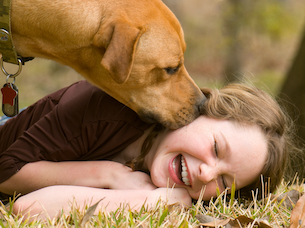AVMA: “Doggie breath” could be a sign of serious disease
Phone: 847-285-6687 · Cell: 847-732-6194
To address the importance of oral health care for pets, the American Veterinary Medical Association (AVMA) is sponsoring National Pet Dental Health Month in February. AVMA President Dr. Jose Arce says regular dental exams are an integral component of a pet’s overall health care, and can help prevent more serious health problems.
“Oral disease is one of the most frequently diagnosed health problem for our dogs and cats, and it can have serious consequences for our pets’ health,” said Dr. Arce. “This is not just a matter of bad breath or stained teeth. In addition to causing receding gums, tooth loss and often significant pain, bacteria in the mouth can enter the bloodstream, potentially affecting the heart, liver and kidneys, which can be life-threatening.”
According to the American Veterinary Dental College, most dogs and cats have some evidence of periodontal disease by the age of three, often indicated by bad breath, a change in eating or chewing habits, pawing at the face and mouth, and depression.
Although daily toothbrushing is advised for dogs and cats, a study published in the Journal of Veterinary Dentistry showed that only two percent of dog owners follow through with this practice. In addition, a survey of pet owners showed that only 14 percent of dogs and 9 percent of cats receive dental care at the veterinarian’s office. Pet owners should work with their veterinarians to begin a pet dental care routine at home, in addition to regular dental exams and professional dental cleanings.
Dr. Arce says a pet’s teeth should be checked twice a year by their veterinarian or a board-certified veterinary dentist for early signs of a problem and to keep their mouths healthy. However, pet owners should also have their pet’s teeth checked if they observe any of the following problems:
- Bad breath
- Broken or loose teeth
- Extra teeth or retained baby teeth
- Teeth that are discolored or covered in tartar
- Abnormal chewing, drooling, or dropping food from the mouth
- Reduced appetite or refusal to eat
- Pain in or around the mouth
- Bleeding from the mouth
- Swelling in the areas surrounding the mouth
What to expect
Pet dental visits begin with an oral exam of your pet’s mouth by a veterinarian. Radiographs (x-rays) may be needed to evaluate the health of the jaw and the tooth roots below the gumline. Because most dental disease occurs below the gumline, where you can’t see it, a thorough dental cleaning and evaluation are performed under anesthesia. Dental cleaning includes scaling (to remove dental plaque and tartar) and polishing, similar to the process used on your own teeth during your regular dental cleanings.
After the exam, your veterinarian will make recommendations based on your pet’s overall health and the health of your pet’s teeth, and provide you with options to consider. Talk with your veterinarian about any dental products, treats, or dental-specific diets you’re considering for your pet, or ask your veterinarian for their recommendations.
Why does dentistry require anesthesia?
No matter how smart they are, your pet does not understand the benefit of dental procedures, and they react by moving, trying to escape or even biting. Anesthesia makes it possible for veterinarians to perform dental procedures with less stress and pain for your pet and allows cleaning below the gumline where most dental disease occurs. If radiographs (x-rays) are needed, your pet needs to be very still to get good images, and this is unlikely without heavy sedation or anesthesia. Most pets can go home the same day of the procedure, although they might seem a little groggy for the rest of the day.
To learn more about dental care for pets, including an instructional video on brushing pets’ teeth, visit avma.org/petdental. For more information, contact Michael San Filippo, AVMA media relations manager, at 847-732-6194 (cell/text) or msanfilippo@avma.org.
The AVMA, founded in 1863, is one of the oldest and largest veterinary medical organizations in the world, with more than 97,000 member veterinarians worldwide engaged in a wide variety of professional activities and dedicated to the art and science of veterinary medicine.

Short URL: http://caninechronicle.com/?p=224156
Comments are closed












